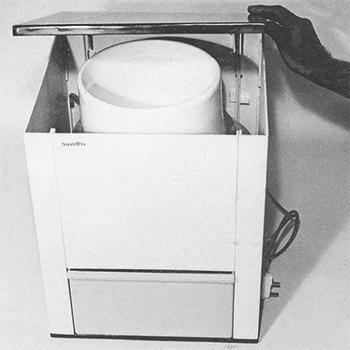Raw materials often occur in sizes that are too large for the user, and therefore, they must be reduced in size. Depending on whether the material is a solid or a liquid, this size reduction operation can be divided into two major categories. If it is a solid, the operations are known as grinding and cutting; if it is a liquid, the operations are known as emulsification or automization. Grinding and cutting reduce the size of solid materials by mechanical action, dividing them into smaller particles. Perhaps the most extensive application of grinding in the food industry is in the milling of wheat grains to flour, but it is used on many other occasions, such as in the grinding of corn for the manufacture of corn starch, the grinding of sugar, and the milling of dried foods.
More than 6000 years ago, people ceased to eat grain in its wild state and began to break it up with a rude kind of pestle and mortar. Later, a primitive hand mill came into use. This consisted of two stones with roughened surfaces between which the grain was ground. The quern, the next mill to emerge, was made of two circular stones, the upper one rotating around the lower, to which it was attached by a metal or wooden pin. The corn was introduced between the stones by means of a funnel in the upper stone, which also had a small hole near its edge into which a stick was inserted to serve as a handle. The quern is still used by semi-civilised people, and in remote parts of Ireland, the Hebrides, and the Shetlands. Down to 1874, the grindstone remained the basis of the flour mill, but the power was supplied by animal labour, wind, and water. In smaller mills, grind stones are still used, and certain types of flour are produced. They are made of ‘buhr’, a very hard silicate. They are from 4 to 6 ft. in diameter, and their surfaces are grooved or furrowed from the centre to the circumference. The ‘hopper’ supplies the grain through the centre of the upper stone; the wheat is pushed along the grooves and broken upon the ridges.
Modern method: In modern flour mills, chilled iron rollers have taken the place of grind stones. The first successful steam mill was erected in London in 1784, and iron rollers were first used in 1840, following their introduction in Budapest. Hungary became the world centre for flour mills on account of this improvement. Minneapolis soon adopted it, becoming the most important flour mill centre in the world. It remains one of the most important centres today. Since 1880, the system of roller milling has been in operation in all large mills. As a source of motive power, steam has largely been replaced by electricity.
A domestic flour mill is a smaller version of a commercial flour mill. The traditional pair of stone wheels is driven by an electric motor. The other main parts of the mill are the hopper and the drawer for collecting the flour. It has been found out that mostly housewives operate the flour mill, and as it is, no ergonomic factors have been considered in the present design. It is also felt necessary to increase the aesthetic value, reduce the cost, and make its operation easier so that its services could be extended to a larger number of people.

